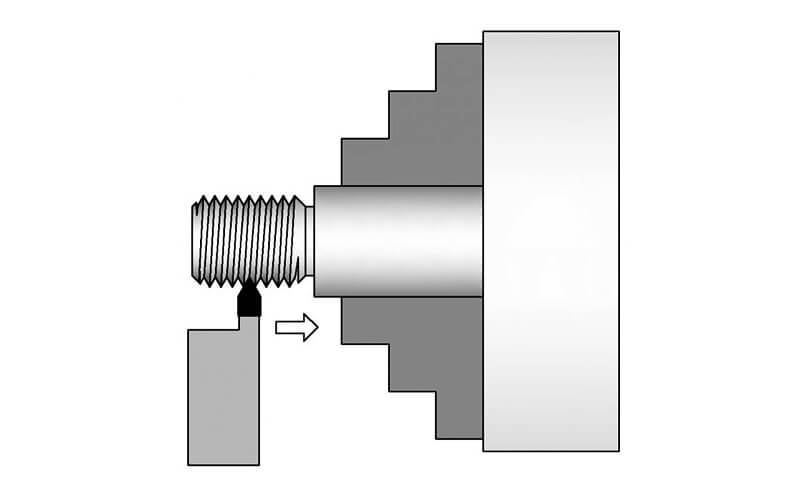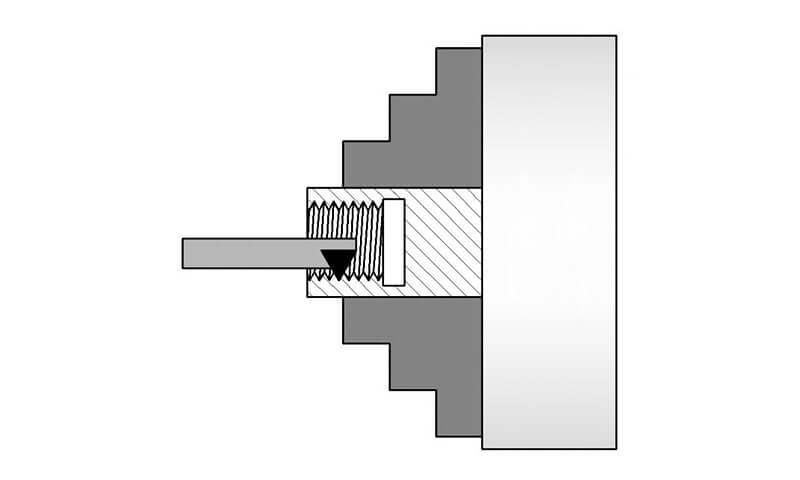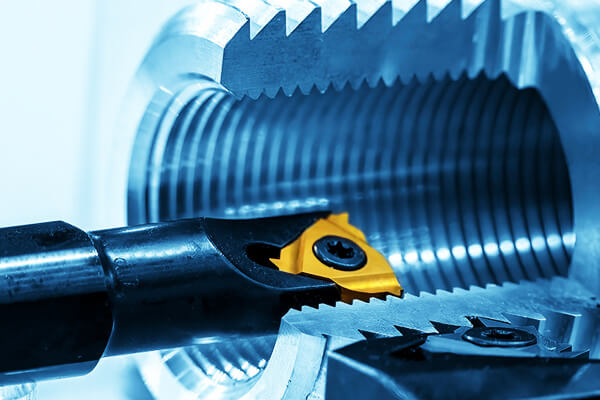1. Bevezetés
Threads are the unsung heroes that ensure parts stay together across a wide range of industries, az autóipartól az űrhajózásig.
They provide secure, adjustable connections between components, making them indispensable in manufacturing.
Ebben a bejegyzésben, we will explore the various types of threads available and the geometric parameters that define their functionality.
By delving into these aspects, we aim to equip you with the knowledge necessary to make informed decisions when designing or selecting threaded fasteners.
2. What Are Threads?
A gépiparban, a thread is a helical ridge or groove wrapped around a cylindrical or conical surface.
Threads are essential for creating fasteners such as screws, csavaroz, és dióféléket, and are also integral to fluid control systems like valves and pipes.
The primary function of threads is to create a mechanical connection between two parts, allowing them to fit together securely.

Thread Pitch:
Thread pitch is the distance between corresponding points on adjacent threads. It directly affects the joint’s strength and stability.
A finer pitch (smaller distance between threads) results in a tighter, stronger joint, but can also make assembly more difficult.
Másrészt, a coarser pitch is easier to assemble but may compromise the strength of the joint.
Importance of Thread Design:
Thread design is not just about creating a functional connection—it’s about ensuring the right balance between strength, ease of manufacturing, and performance under load.
The choice of thread type and its geometric parameters, such as pitch and depth, can significantly affect the performance of the thread in various applications.
3. Types of Threads
External Threads
External threads form on the outer surface of parts, such as screws and bolts. These threads engage with internal threads to create secure connections.
Common examples include ISO metric threads and Unified National (UN) szálak, which are widely used in international and North American contexts, illetőleg.

- ISO Metric Threads: Used globally, ISO threads come in various sizes, from M1.6 to M100.
Each size specifies the diameter and pitch, ensuring compatibility across different manufacturers. - Unified National Threads: Predominantly used in North America, UN threads have specific diameters and pitches, kezdve #0-80 UNC to 4-40 UNF.
The fine (UNF) and coarse (UNC) variants cater to different application needs.
Internal Threads
Internal threads form inside holes or components like nuts and inserts. They work in conjunction with external threads to form stable connections.
Tapped holes and threaded inserts exemplify this type of thread, ensuring strong and reliable fastening solutions.

- Tapped Holes: Ideal for applications requiring precise alignment and high strength.
A standard M6 tapped hole can handle up to 5,000 N of tensile force, making it suitable for heavy-duty machinery. - Threaded Inserts: Often used in softer materials like plastic or aluminum.
Inserts can increase the durability and reliability of the connection, providing a robust solution for repeated assembly and disassembly.
Types of Thread Forms

- V-Thread: The most common thread form, characterized by its V-shaped profile. It is widely used in general-purpose fasteners due to its robustness and ease of manufacture.
V-threads typically have a 60° angle, offering balanced load distribution and easy production. - Square and Acme Threads: Designed for power transmission applications, where they excel in handling heavy loads efficiently.
Their square and trapezoidal profiles minimize wear and tear while maximizing load-bearing capacity.
Square threads can achieve efficiencies up to 95%, making them ideal for lead screws and jackscrews. - Buttress Threads: Optimized for applications requiring high axial loads in one direction, such as presses and vises.
Their asymmetrical design allows for better resistance against axial forces. Buttress threads can support up to 70% more load compared to V-threads in unidirectional applications. - Knuckle Threads: Used in applications where a seal is necessary, such as pneumatic fittings. Their rounded shape provides a natural sealing effect, a szivárgások megakadályozása.
Knuckle threads can reduce leakage rates by up to 80%, enhancing fluid and gas-tight connections. - Worm Threads: Utilized in worm gears for power transmission, providing a compact and efficient way to transfer motion at right angles.
Worm threads can achieve reduction ratios up to 1:100, making them invaluable in gearboxes and steering mechanisms. - Single and Multi-Start Threads: Single-start threads have one continuous helix, whereas multi-start threads feature multiple starts, allowing for faster engagement but potentially less strength.
Multi-start threads can speed up the threading process by up to 50%, improving assembly efficiency.
4. Geometric Parameters of Threads
Understanding the geometric parameters of threads is essential for achieving precision in manufacturing. Here’s a closer look at the key parameters:

Outer Diameter (Major Thread Diameter)
This is the largest diameter of the thread, defining the fitting size. For external threads, it’s the outermost diameter; for internal threads, it’s the innermost.
The major diameter ensures proper fit and function, with tolerances often specified in microns to maintain accuracy.
- Példa: An M10 bolt has a major diameter of 10mm, ensuring precise fitment in compatible nuts or tapped holes.
Belső átmérő (Minor Thread Diameter)
The smallest diameter of the thread impacts the material thickness and thread engagement. For external threads, it’s the inner diameter; for internal threads, it’s the outer.
The minor diameter plays a critical role in determining the strength and durability of the thread.
- Hatás az Erőre: A larger minor diameter increases material thickness, enhancing thread strength.
Például, an M10 x 1.5 thread has a minor diameter of approximately 8.376mm, contributing to higher load-bearing capabilities.
Pitch átmérő (Effective Diameter)
The diameter at which the thread pitch is measured represents the theoretical point of contact between mating threads.
This parameter is crucial for ensuring proper engagement and load distribution.
- Jelentőség: The pitch diameter affects how evenly the load is distributed across the thread flanks.
Például, an M10 x 1.5 thread has a pitch diameter of about 9.026mm, optimizing load distribution and reducing stress concentrations.
Ólom
The distance along the axis of the thread traveled by a single start in one complete revolution. In multi-start threads, lead equals the number of starts multiplied by the pitch.
Lead influences the speed and efficiency of thread engagement.
- Hatékonyság: Multi-start threads with a larger lead can significantly reduce assembly time.
Például, a double-start M10 x 1.5 thread has a lead of 3mm, enabling faster threading compared to a single-start thread.
Tooth Angle
The angle between the sides of the threads influences load distribution and manufacturability.
Common angles include the 60° V-thread, which offers a balance between strength and ease of production.
- Effect on Strength: A 60° angle provides optimal load distribution, minimizing stress concentrations and maximizing thread life.
Other angles, like the 29° Acme thread, cater to specific applications requiring high efficiency.
Additional Parameters
- Thread Depth: The distance between the crest (top of the thread) and the root (bottom of the thread).
Depth affects strength, fáradtság ellenállás, and sealing performance. Például, increasing thread depth can enhance sealing properties by up to 30%. - Flank and Crest: The flank refers to the sides of the thread, while the crest is the top surface.
Their geometry influences friction, kopásállóság, and thread engagement. Proper flank angles can reduce friction by up to 20%, a működési hatékonyság javítása. - Root Radius: The rounded area at the base of the thread. A larger radius improves durability by reducing stress concentrations. Increasing the root radius by even 0.1mm can extend thread life by up to 25%.
5. Thread Standards
Thread standards are crucial for ensuring compatibility and interchangeability across different manufacturers and regions.
They provide a uniform set of specifications that guide the design, termelés, and application of threads.
This section delves into some of the most widely recognized thread standards, highlighting their unique features and applications.
Metric Threads (Izo)
The International Organization for Standardization (Izo) has established metric threads as the global standard for fasteners.
These threads are specified by diameter and pitch, with diameters ranging from M1.6 to M100 and pitches varying accordingly.
ISO metric threads ensure consistency in manufacturing processes and facilitate seamless integration of components from diverse suppliers.
- Fontosság: The adoption of ISO standards promotes global compatibility and reduces the risk of mismatches or misfits between threaded parts.
Például, an M10 x 1.5 thread is universally recognized, ensuring consistent quality and performance. - Alkalmazások: ISO metric threads are used extensively in the automotive, űrrepülés, gépek, és építőipar.
Their widespread use ensures that engineers can rely on standardized dimensions for reliable connections.
British Standard Threads
British Standard Threads encompass various types designed for specific applications, particularly in plumbing and hydraulic systems. Two prominent types include:
- BSPP (Brit szabványos cső párhuzamos): BSPP threads feature parallel flanks, providing a leak-proof seal through gaskets or sealing compounds.
They are commonly used in hydraulic systems where reliability and durability are paramount.
-
- Alkalmazások: BSPP threads are prevalent in European plumbing systems, offering reliable connections in water and gas lines. Their design ensures minimal maintenance and long-term integrity.
- BSPT (Brit szabványos cső kúpos): BSPT threads use a tapered design to achieve a tighter seal without additional sealing materials.
They excel in high-pressure applications, maintaining integrity under extreme conditions.
-
- Alkalmazások: BSPT threads dominate North American pipe fittings, ensuring secure seals in industrial applications such as oil and gas pipelines.
Unified Thread Standard (UTS)
Predominantly used in North America, the Unified Thread Standard (UTS) offers a set of specifications optimized for American manufacturing practices.
UTS threads differ slightly from ISO standards, particularly in terms of pitch series and tolerances.
Common examples include UNC (Unified National Coarse) and UNF (Unified National Fine).
- Különbségek: UTS threads like 1/4-20 UNC offer unique advantages for North American industries. The difference in pitch and diameter ensures compatibility with local machinery and tools.
- Alkalmazások: UTS threads are widely used in the automotive, építés, and manufacturing sectors in North America.
Their specifications cater to the region’s engineering practices, ensuring reliable and efficient connections.
Other Thread Standards
Several other thread standards cater to specialized applications, ensuring optimal performance in niche markets:
- BSP (British Standard Pipe): BSP threads are widely used in European plumbing systems, providing reliable connections in water and gas lines.
They come in two forms: BSP parallel (BSPP) and BSP tapered (BSPT), mindegyik különböző alkalmazásokhoz alkalmas.
-
- Szakosodás: BSP threads address the unique requirements of plumbing systems, ensuring reliable connections and minimal leakage.
- Tipizma (Nemzeti csőszál): NPT threads dominate North American pipe fittings, ensuring secure seals in industrial applications.
They are available in straight (NPSM) and tapered (Tipizma) versions, each designed for specific sealing needs.
-
- Alkalmazások: NPT threads are essential in oil and gas pipelines, vegyipari feldolgozó üzemek, és HVAC rendszerek, where reliable sealing is critical.
- Whitworth Threads (BSW): Originally developed in the UK, Whitworth threads are now less common but still used in certain legacy applications.
They have a characteristic 55° angle, differing from the 60° angle of ISO and UTS threads.
-
- Legacy Use: BSW threads are found in older machinery and equipment, maintaining compatibility with historical designs.
- Ő az (Japán ipari szabvány): Used in Japan, the JIS thread standards are used for a variety of applications, including screws, csavaroz, és csőrendszerek.
- TÓL (Deutsches Institut für Normung): The German standard for threads, often used in automotive and mechanical engineering applications.
- ACME Threads: Commonly used for power transmission systems, ACME threads have a trapezoidal profile, which allows them to carry heavy axial loads in linear motion applications,
such as in lead screws and machine tools. - Trapezoidal Threads: Similar to ACME threads, trapezoidal threads are used for power transmission and in high-load applications.
These threads have a larger pitch and flatter angle than traditional V-threads, which makes them more suitable for heavier-duty cycles.
Transitioning Between Standards
When working with components from different regions or industries, it’s essential to understand how to transition between thread standards.
Adapters and conversion charts can help bridge the gap, ensuring seamless integration of parts.
Engineers must also consider factors like material compatibility, teherbírása, and environmental conditions when selecting threads for cross-standard applications.
6. How Thread Design Affects Performance
The design of threads significantly impacts their performance in various ways:
Terhelés-elosztás
Thread geometry determines how tensile, shear and torsional loads are handled, ensuring the threads can withstand the stresses imposed during use.
Proper load distribution minimizes stress concentrations, extending thread life.
- Optimization: Engineers can optimize load distribution by adjusting parameters like pitch and tooth angle.
Például, using a finer pitch can distribute loads more evenly, reducing the risk of thread failure.
Tartósság
Factors like pitch, flank angle, and depth contribute to the lifespan of a thread under stress, enhancing reliability over time.
Robust thread designs withstand repeated loading and unloading cycles without compromising integrity.
- Enhanced Lifespan: Increasing thread depth and root radius can boost durability by up to 40%, making the threads more resistant to wear and tear.
Sealing and Tightness
Proper thread geometry ensures effective sealing properties, especially critical in fluid and gas-tight applications, preventing leaks and maintaining integrity.
Precise thread dimensions and finishes play a vital role in achieving a perfect seal.
- Sealing Efficiency: Using knuckle threads or adding a sealing compound can enhance sealing performance by up to 50%, ensuring reliable connections in harsh environments.
7. Következtetés
Understanding the types of threads and their geometric parameters is fundamental to precision manufacturing.
Engineers and designers who grasp these concepts can make more informed decisions, leading to improved product performance and reliability.
By considering the unique requirements of each application, professionals can select or design threads that meet the highest standards of quality and efficiency.
Embracing this knowledge empowers us to innovate and optimize our manufacturing processes, ensuring that every threaded component performs flawlessly in its intended environment.
By exploring these detailed aspects, we transition smoothly from understanding basic principles to applying advanced techniques in real-world scenarios.
This comprehensive guide aims to provide valuable insights, helping engineers and manufacturers achieve excellence in their projects.
DEZE offers a comprehensive range of services, including engineering expertise, prototípus készítés, and specialized solutions for bearings, rögzítőelemek, és szálak.
This can be an advantage for customers looking for end-to-end support in their manufacturing projects.
We are committed to providing you with a one-stop service and thread solution that fits your project. If you have any needs feel free to Vegye fel velünk a kapcsolatot!



